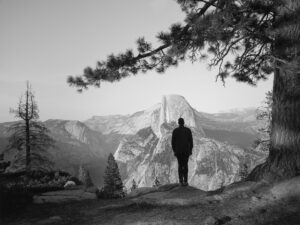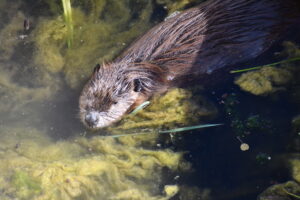Jeff Miller is a man on a mission: He is dedicated to being an effective voice for endangered species and preserving the Northern California habitats they depend on for survival. He currently pursues this mission as founding director of the Alameda Creek Alliance — with two “Leaping Steelhead” awards under his belt for his efforts to restore Alameda Creek — and as a conservation advocate for the Center for Biological Diversity. Jeff has been involved in numerous campaigns, from condor protection to pesticides reduction to Bay Area urban-sprawl issues. In his spare moments he rambles around the parks and open spaces he works so hard to protect.
BN: When did you come to the Bay Area?
JM: I was born here, in 1963. I grew up in Berkeley and El Cerrito. I roamed the East Bay parks as a kid, playing in creeks and catching crawdads, and hiking everywhere. In my twenties and thirties I traveled the western states blocking logging roads with Earth First! I eventually decided I wanted to focus on environmental issues in the Bay Area.
BN: How did you get involved with the Alameda Creek Alliance?
JM: I founded the Alliance in 1997, right after steelhead trout were listed as threatened species under the Endangered Species Act. I was looking for a compelling project to protect the wildlife and natural areas of the East Bay and was inspired by the advocacy work to protect coho salmon in Lagunitas Creek in Marin. Through researching creeks in the East Bay that had potential for restoring salmon and steelhead trout, I got to know Alameda Creek and fell in love with it. It’s the largest watershed in the East Bay.
Around the same time I began working with the Center for Biological Diversity, and became a full-time staff member about a decade ago. The Center is the most effective, passionate and fearless conservation organization I know of.
BN: What are you working on now?
JM: The Alameda Creek Alliance is battling Caltrans over a destructive and unnecessary highway widening project in Niles Canyon that would damage trout habitat along Alameda Creek. Caltrans wants to cut nearly 600 trees along the creek and fill portions of the creek and floodplain in an area where we are trying to bring back steelhead trout.
For the past decade (with state and federal permits) we’ve been netting and manually moving steelhead trout so they can access Niles Canyon for spawning. So far only one pair has actually spawned, the first in this watershed in 45 years, but with dam removals, constructions of fish ladders, and increased water flow releases from dams, we expect steelhead to come back.
So we’ve helped organize major opposition to the project in Niles and Fremont. We hope to change Caltrans’ one-size-fits-all approach to road projects that would damage important habitat and degrade the scenic beauty of the Canyon. There are less destructive alternatives for road safety that do not involve highway widening and filling in the creek; it’s such a 1950s mentality!
BN: What do you like most about the work you’re doing?
JM: Mostly I like being able to speak up uncompromisingly for wildlife and natural areas. Salmon restoration is particularly rewarding because so many ecological issues are hitched to the restoration of watersheds, and all kinds of social issues are implicated in society’s impacts on the life cycle of migratory fish. I get to work on a wide array of Bay Area endangered species protection issues with the Center, and have learned an incredible amount about how to use policy, laws, community organizing, outreach and media to be maximally effective.
BN: Who or what in the Bay Area inspires you these days?
JM: The Martinez beavers showing up in an urban area gave me a lot of hope about the tenacity of wildlife, as do the steelhead that continue to return to Alameda Creek despite the decades of habitat degradation.
My girlfriend Amy, who is the Director of the Environmental Action Committee in West Marin, where we live, is a huge inspiration to me. She is working to protect the wilderness status of Drakes Estero, prevent industrial wind development along the Marin coast, and organizes the Point Reyes Bird Festival.
BN: What’s your favorite park, hike, or place to go in nature in the Bay Area?
JM: Wow, tough to pick just one. I’m partial to Sunol Regional Wilderness, up in the really gorgeous part of the upper Alameda Creek watershed, but I also love to ramble around in the huge protected areas in West Marin, particularly Mount Vision, Bolinas Lagoon, and anywhere in Point Reyes.
Note: Jeff and ACA will be in Alameda County court on Thursday, June 24 to seek a permanent injunction against CalTrans from continuing with construction on the Niles Canyon project. “Win or lose this round, we’re going to continue to fight it,” he says.
Visit Alameda Creek Alliance’s website, alamedacreek.org, to find out more about the Niles Canyon issue and receive action alerts.

.jpg)



